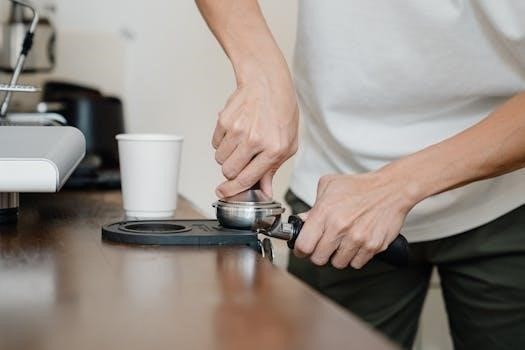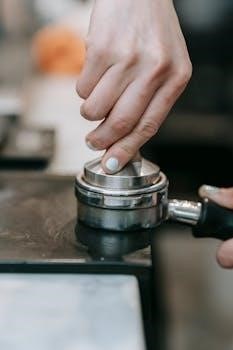Overview of DeLonghi Manual Coffee Machines
DeLonghi manual espresso machines offer a hands-on approach to coffee brewing. These machines allow users to control the brewing process, from grinding and tamping to pulling the perfect shot. They are for coffee enthusiasts who appreciate the art of espresso.
Key Features and Benefits
DeLonghi manual coffee machines boast several key features. These include adjustable settings for grind size, water temperature, and pressure, giving users control over extraction. They also feature powerful steam wands for creating milk foam for cappuccinos and lattes. Benefits include the ability to customize coffee to your preference, enjoying a fresh cup of espresso, and the durability associated with DeLonghi products.
Understanding Your DeLonghi Model
To maximize your DeLonghi manual coffee machine’s potential, understanding your specific model is essential; Each model has unique features and functionalities. Knowing your model ensures proper operation and maintenance.
Identifying Your Specific Model Number
Finding your DeLonghi manual coffee machine’s model number is crucial for accessing the correct resources and support. The model number is typically located on a sticker or plate affixed to the machine. Common locations include the bottom of the unit, the back panel, or behind the water tank. Look for a combination of letters and numbers, such as EC680 or EC860. This identifier unlocks specific user manuals and troubleshooting guides, ensuring you have the right information for your machine.
Locating and Downloading the Correct User Manual
Once you’ve identified your DeLonghi manual coffee machine’s model number, finding the correct user manual is the next step. Visit the official DeLonghi website and navigate to the “Support” or “Manuals” section. Enter your model number into the search bar to find the corresponding manual. Download the PDF version for easy access on your computer or mobile device. The manual provides essential information on setup, operation, cleaning, and troubleshooting for your specific machine model.

Initial Setup and Preparation
Proper initial setup ensures optimal performance and longevity for your DeLonghi manual coffee machine. This involves carefully assembling all components, connecting them correctly, and priming the machine before its first use to ensure proper water flow.
Assembling the Machine and Components
Carefully unpack your DeLonghi manual coffee machine, ensuring all components are present, including the water tank, portafilter, filter baskets, and drip tray. Refer to the user manual for a detailed parts list and assembly diagram. Attach the drip tray securely to the base of the machine. Insert the water tank into its designated slot, ensuring it’s properly seated. Place the appropriate filter basket into the portafilter. Correct assembly is crucial for the machine’s proper functioning.
Priming the Machine Before First Use
Priming your DeLonghi espresso machine is essential before its initial use. Fill the water tank with fresh, filtered water to the maximum level. Turn on the machine and allow it to heat up. Follow the instructions in your user manual to initiate the priming process; this usually involves running water through the group head without coffee. This process removes any manufacturing residue and ensures the machine is ready to brew espresso. Repeat the priming process a few times.
Brewing Espresso⁚ A Step-by-Step Guide
Brewing espresso with a DeLonghi manual machine involves grinding fresh beans, tamping correctly, and extracting the shot. This guide provides detailed steps for achieving optimal flavor and crema, ensuring a perfect espresso every time.
Grinding and Tamping Coffee Beans
Achieving the perfect espresso starts with the right grind. Use freshly roasted coffee beans and grind them to a fine, consistent texture. A burr grinder is recommended for optimal results. After grinding, evenly distribute the coffee grounds in the portafilter basket. Tamping is crucial; apply about 30 pounds of pressure to compress the grounds firmly and evenly. A proper tamp ensures even water flow and a rich, flavorful extraction. Uneven tamping can lead to channeling and a weak, sour-tasting espresso. Experiment with grind size and tamping pressure to fine-tune your technique.
Pulling a Single or Double Shot
Once the coffee is properly ground and tamped, it’s time to pull your shot. Secure the portafilter into the DeLonghi machine’s group head. For a single shot, aim for about 1 ounce of espresso in approximately 25-30 seconds. For a double shot, extract around 2 ounces in the same timeframe. Monitor the extraction; a good shot will have a rich, dark color with a creamy crema on top. Adjust your grind size and tamping if the extraction is too fast (under-extracted) or too slow (over-extracted). Experiment and refine your technique for the perfect espresso.

Frothing Milk for Cappuccinos and Lattes
DeLonghi manual coffee machines often feature a steam wand for frothing milk. This allows you to create cappuccinos, lattes, and other milk-based espresso drinks. Mastering the steam wand is key to achieving the desired milk texture.
Using the Steam Wand Effectively
To effectively use the steam wand on your DeLonghi manual coffee machine, start by purging any condensation. Submerge the tip of the wand slightly below the milk’s surface to introduce air and create foam. Gradually lower the pitcher to heat the milk, creating a swirling motion. Avoid creating large bubbles. Achieve a microfoam texture for latte art and a richer cappuccino. Clean the wand immediately after use to prevent milk buildup.
Achieving the Desired Milk Texture
Achieving the desired milk texture with a DeLonghi manual coffee machine requires practice. For lattes, aim for a silky, microfoam texture by incorporating minimal air. For cappuccinos, create a thicker, more voluminous foam by introducing more air initially. Control the steam wand’s position and the pitcher’s angle to regulate air intake. Tap the pitcher on the counter and swirl the milk to eliminate large bubbles and create a consistent texture. Experiment with different techniques to find your preferred milk consistency.

Cleaning and Maintenance Procedures
Regular cleaning and maintenance are crucial for prolonging the life of your DeLonghi manual coffee machine. This includes daily tasks like wiping down the machine and descaling to ensure optimal performance and prevent mineral buildup.
Daily Cleaning Tasks
After each use of your DeLonghi manual espresso machine, it’s essential to perform a few simple daily cleaning tasks. This includes removing the portafilter and discarding the used coffee grounds. Rinse the portafilter and filter basket thoroughly with warm water. Wipe down the exterior of the machine with a damp cloth to remove any coffee splatters. Clean the drip tray and water reservoir regularly to prevent residue and bacteria buildup. These habits maintain hygiene and ensure your machine’s longevity.
Descaling the Machine Regularly
Regular descaling is crucial for maintaining your DeLonghi manual espresso machine’s performance. Mineral buildup from water can affect the machine’s heating efficiency and water flow. Follow the instructions in your user manual to descale the machine, typically every two to three months, depending on water hardness. Use a descaling solution specifically designed for coffee machines to dissolve mineral deposits. Descaling helps to ensure optimal espresso extraction and prolongs the lifespan of your DeLonghi machine, preventing damage from scale accumulation and keeping your coffee tasting great.
Troubleshooting Common Issues
DeLonghi manual coffee machines, like all appliances, can experience occasional issues. Addressing these promptly ensures continued operation. Common problems include water flow issues, milk frothing difficulties, and leaks. Consult your manual for solutions.
Addressing Problems with Water Flow
If your DeLonghi manual coffee machine is experiencing water flow problems, several factors could be responsible. First, ensure the water reservoir is filled adequately. Check for any visible obstructions in the water intake. Next, descale the machine as mineral buildup can impede water flow. Confirm the pump is functioning correctly, listening for its usual sound during operation. If the issue persists, consult the user manual or contact DeLonghi support for further assistance.
Resolving Issues with Milk Frothing
Encountering problems with milk frothing on your DeLonghi manual espresso machine? Start by verifying the steam wand is clean and free of milk residue. Ensure you’re using fresh, cold milk for optimal frothing. Purge the steam wand before and after each use to remove condensation. Check the steam pressure; it might need adjustment. If the issue persists, descale the machine, as mineral buildup can affect steam production. Refer to your user manual or DeLonghi support for further troubleshooting tips.

Advanced Techniques and Customization
Elevate your coffee game with advanced techniques on your DeLonghi manual machine. Experiment with grind size, coffee bean types, and tamping pressure. Explore latte art and temperature surfing for optimal extraction. Fine-tune your brewing process for personalized results.
Adjusting Grind Size for Optimal Extraction
Achieving the perfect espresso with your DeLonghi manual machine hinges on the grind size. A too-coarse grind results in weak, under-extracted coffee, while a too-fine grind leads to bitter, over-extracted shots. Adjust the grinder incrementally, noting the changes in taste and extraction time. Aim for a consistent, even grind that allows for a balanced, flavorful espresso. Experimentation is key to finding the sweet spot for your beans and machine. Remember that the ideal grind size can vary depending on the bean type and roast level.
Experimenting with Different Coffee Beans
One of the joys of owning a DeLonghi manual coffee machine is the ability to explore a wide variety of coffee beans. Different beans offer distinct flavor profiles, aromas, and acidity levels. Try single-origin beans for a unique taste experience, or blends for a more balanced cup. Consider the roast level, as lighter roasts tend to be more acidic, while darker roasts offer a bolder, more intense flavor. Keep notes on your preferences and adjust your grind size and tamping technique accordingly to unlock each bean’s full potential.
Safety Precautions and Warnings
Operating a DeLonghi manual coffee machine requires caution. Always be mindful of hot surfaces and steam to prevent burns. Ensure proper handling of electrical components to avoid shocks. Read the safety instructions carefully before use.
Avoiding Scalding and Burns
When using a DeLonghi manual coffee machine, scalding and burns are potential hazards if precautions aren’t taken. Always allow the machine to cool down before cleaning or disassembling it. Be cautious when handling the steam wand, as it emits hot steam that can cause severe burns. Never touch hot surfaces like the group head or the boiler housing during or immediately after brewing. Use oven mitts or heat-resistant gloves when handling hot components, and keep children away from the machine during operation to prevent accidental contact with hot parts.
Proper Handling of Electrical Components
Safe operation of your DeLonghi manual coffee machine involves careful handling of its electrical components. Before any maintenance or cleaning, always unplug the machine from the power outlet to prevent electrical shock. Ensure the power cord is in good condition and not damaged. Never immerse the machine or its electrical parts in water or other liquids. If you notice any signs of electrical malfunction, such as sparks or unusual noises, discontinue use immediately and consult a qualified technician. Avoid overloading the electrical circuit by plugging the coffee machine into a dedicated outlet.
